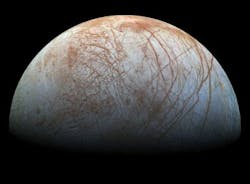Reprocessed image shows color view of Jupiter’s moon Europa
This image—which was captured in the 1990s by NASA’s Galileo Solid-State Imaging (SSI) camera—was recently reprocessed to show a colorful, stunning view of Jupiter's icy moon Europa.
MORE ARTICLES
Vision-guided robot learning to fly real airplanes
NASA team developing “swarmie” robots for autonomous scouting and resource collection
Vision Systems Design announces 2015 Innovators Awards program
Images of the moon were previously released as a mosaic in lower resolution and strongly enhanced color (see here), but the images were assembled into a realistic color view of the surface that approximates how Europa would appear to the human eye in the new version.
The SSI camera is a modified flight spare of the 1500 mm focal length, all-spherical, narrow-angle telescope flown on NASA’s Voyager mission. It features a 12.19 x 12.19 mm 800 x 800 line silicon virtual phase CCD image sensor and a field of view of 0.46°. The camera was operated in eight filtered band passes from 350 – 1100 nm. The SSI’s optics featured anti-reflective coatings, and as a result, the short wavelength sensitivity was more limited than the camera on Voyager, thus there was no analog for the ultraviolet passband on the SSI. Aside from that, according to NASA, the spectral coverage was superior, both in total bandwidth and resolution, to Voyager’s narrow-angle camera. The eight-position filter wheel, also inherited from Voyager, consisted of three broad-band filters: violet (404 nm), green (559 nm), and red (671 nm).
SSI’s broad-band filters allowed for the reconstruction of visible color photographs and were compatible with the Voyager passbands. Four of the filters were chosen to optimize performance of the SSI in the near-infrared (NIR): two for methane absorption bands (727 nm and 889 nm), one for continuum measurements (756 nm), and one to provide spectral overlap with the NIR mapping spectrometer (986 nm). The final filter was a clear filter (611 nm) with a very broad (440 nm) passband.
Images taken with this camera through NIR, green, and violet filters were combined to produce the image. The images were also corrected for light scattered outside of the image in order to provide a color correction that was calibrated by wavelength. Gaps in the images were filled with simulated color based on the color of nearby surface areas with similar terrain types. The scene shows long cracks and ridges across the surface of the moon, interrupted by regions of disrupted terrain where the surface ice crust was broke up and refrozen into new patterns.
The images were taken on the Galileo’s first and fourteenth orbits throughout the Jupiter system in 1995 and 1998, respectively. Image scale is one mile per pixel. Galileo’s mission, which launched on October 18, 1989, ended on September 21, 2003. The Galileo mission was managed by NASA's Jet Propulsion Laboratory in Pasadena, California, for the agency's Science Mission Directorate in Washington. JPL is a division of the California Institute of Technology, Pasadena.
View the NASA press release.
View more information on the SSI camera.
Share your vision-related news by contacting James Carroll, Senior Web Editor, Vision Systems Design
To receive news like this in your inbox, click here.
Join our LinkedIn group | Like us on Facebook | Follow us on Twitter | Check us out on Google +
About the Author

James Carroll
Former VSD Editor James Carroll joined the team 2013. Carroll covered machine vision and imaging from numerous angles, including application stories, industry news, market updates, and new products. In addition to writing and editing articles, Carroll managed the Innovators Awards program and webcasts.
